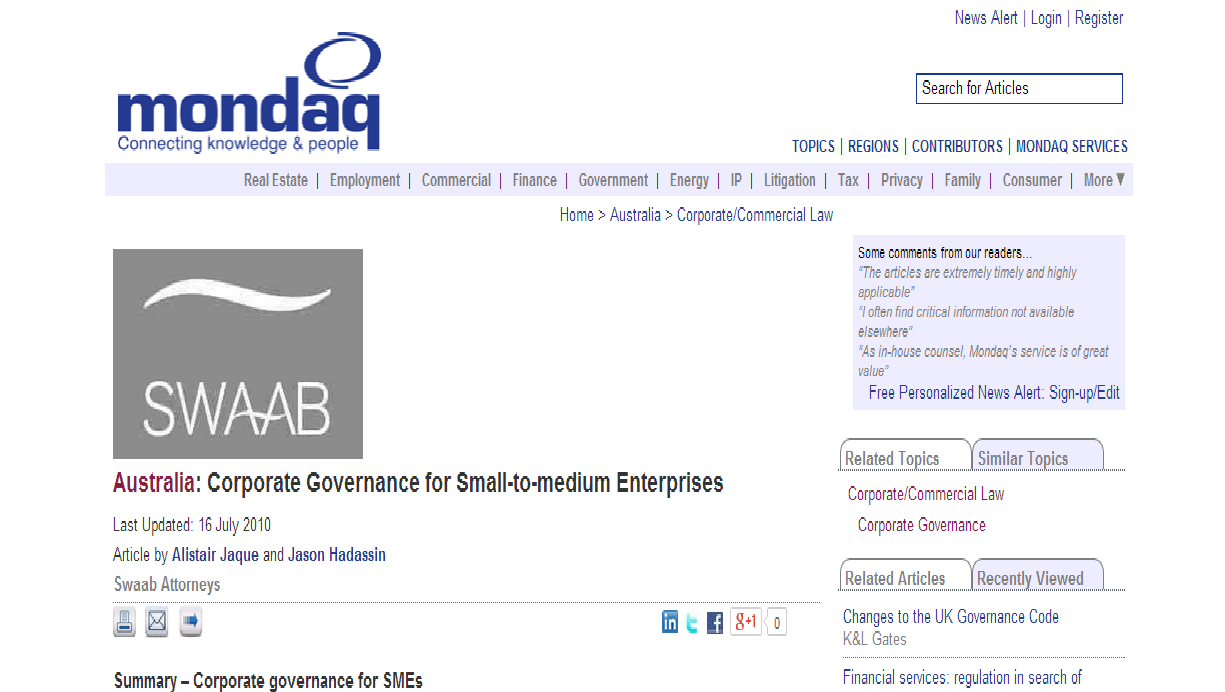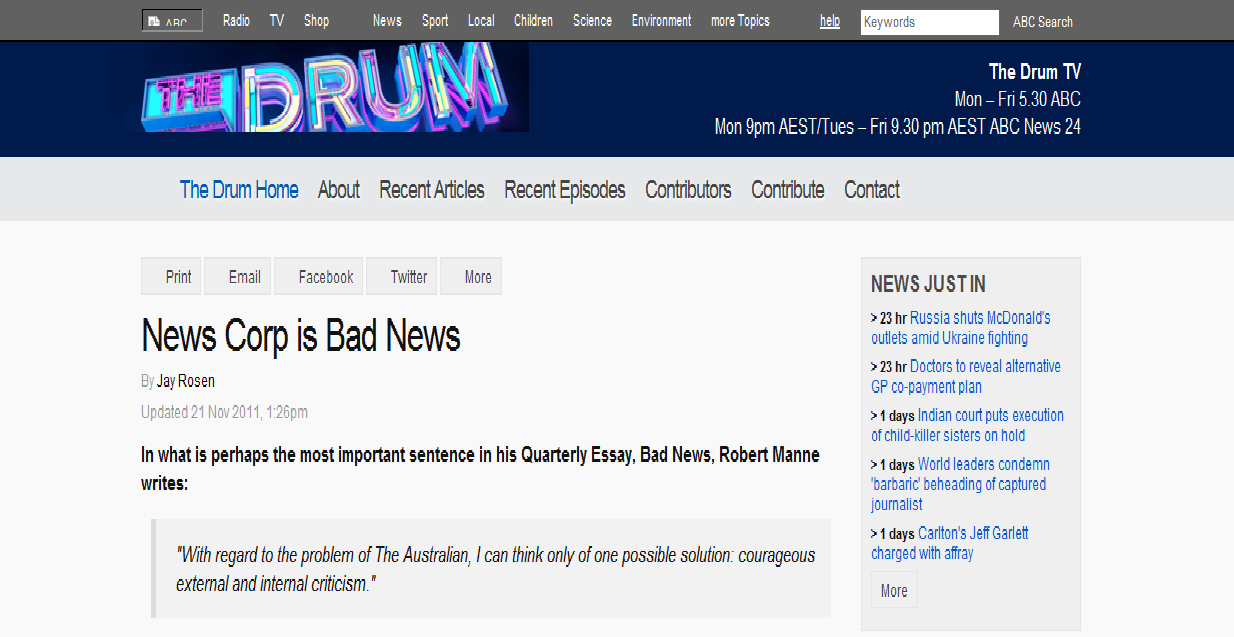The underlying structure of relationships and operations that compel directors to operate accordingly is called corporate governance. Corporate governance includes the mechanism, processes, structure, rights and responsibilities of the investors, directions, regulator and stakeholder. The features of corporate governance include fair treatment among investors and stakeholders, responsibilities of chief executives, stakeholder’s interest, unit operations, ethical behaviour, transparency and disclosures. To mitigate corporate scandals, the government enacted the Corporations Act 2001 and the Australian Securities and Investments Commission Act 2001.
The Australian Securities and Investments Commission review the code of practice of the Corporations Act 2011. However, Australian Corporations Act 2001 utilised the structural framework of the Sarbanes-Oxley Act of 2002. Consequently, the ASX Corporate Governance Council monitors the compliance of directors and executives. ASX listing rules regulate major listings in business organisations. Other regulatory laws include Australian Council of Super Investors (ACSI), Australian Institute of Company Directors (ACID), Australian Shareholders Association, and Australian Security and Investment Commission.
The features of corporate governance in Australia include registration of companies, membership and responsibilities, financial disclosures and transparency, fundraising, takeovers, financial services and market operations. Australian Corporation Act 2011 compels mangers to provide financial reporting, remunerations, and annual reports in conformity with the standard code of practice. The law empowers stakeholders to conduct board elections in the organization (ASX, 2012).
Relationship between law and governance
To explore the relationship between governance and law, we will define governance and law in specific terms. Decisions and policies that govern interest groups, systems and institutions are called governance (Lai & Bello, 2012). As a result, governance can exist without a government and policies without politics. Governance correlates management practices with people’s interest. Three features describe the relationship between law and governance. The features include identity, relativity and difference. First, we can describe governance as a law when it identifies the law and governance. Decisions and policies constitute governance as law.
For example, the regulation and practice of commercial institutions are called customary law. Consequently, the established code of the Internet Corporation for Assigned Names and Numbers (ICANN) is an Internet law. Second, governance in the law describes the policies engrafted in the law.
The relationship can be explained using regulatory responsibilities. For example, government authorities can empower a private organisation to enforce the Consumer Protection Act. As a result, there is a correlation between public and private governance. Thus, state regulatory guidelines can be enforced using private governance. For example, the agreement between the UN and private enterprise, car safety standards enforced by business associations, public-private partnership with the health care system, a citizen’s right and privatisation of prisons. Third, governance through law describes the legal instruments between law and governance.
For example, arbitration, social effects of the law, conflicts of laws and governance. Fourth, governance against the law describes governance by illegal means. For example, protest and civil disobedience, laws against drug cartels and criminal organisations, laws against music piracy, and laws against rebel organisations. Finally, we can establish a relationship between law and governance using three distinct features. The features include identity, relativity and difference. However, the features can be explained in four contexts, which include governance as the law, governance in the law, governance through law and governance against the law.
Regulatory bodies in Australia
Australian regulatory institutions monitor the compliance of companies and organisations. These institutions monitor a company’s investment standards, disclosure policy, annual report, and stakeholder interest (Commonwealth Consolidated Acts, 2012).
- Divestment of Telstra and Government Companies
- National Housing Supply Council
- Australian Political Exchange
- Comcover Advisory Council
- Australian Procurement and Construction Ministerial Council
- COMCAR
- Northern Land Council
- Indigenous Land Corporation
- National Film and Sound Archive
- Great Barrier Reef Marine Park Authority
- Bureau of Meteorology
- WELS (Water Efficiency Labelling and Standards) Regulator
- Supervising Scientist for the Alligator Rivers Region
- Commonwealth Environmental Water Holder
- Wet Tropics Management Authority
- Uluru-Kata Tjuta National Park Board of Management
- Threatened Species Scientific Committee
- Public Lending Right Committee
- Oil Stewardship Advisory Council
- Natural Heritage Trust Ministerial Board
- Council of Financial Regulators
- Consumer Advisory Panel
- Tax Agent Board
- Australian Energy Regulator (AER)
Media article that are examples of good corporate governance


Media articles that are examples of bad corporate governance


Benefits of good corporate governance
Corporate governance describes the practical methods of daily operations in an organisation. These methods cover elements of the organisation. Thus, the benefits of corporate governance in an organisation can be summarised below.
Company’s reputation
An effective framework structured on good corporate governance improves a company’s reputation. Transparent disclosure of a firm’s financial report, policies and daily operations will influence business investment in the organization (McConvill, 2012). As a result, more investors are ready to become part of the organisation. Corporate governance protects the interest of investors willing to become stakeholders in the organisation. Good corporate governance boosts the confidence of individuals and corporate investors. Thus, corporate governance enhances the firm’s reputation (Governance Institute of Australia, 2013).
Eliminate fines and lawsuits
Proper management of firm’s daily operations can eliminate legal complaints and lawsuits. It is the responsibility of the board of directors to review policies that affect the welfare, employee’s right, and operations. Thus, good corporate governance can be used to resolve disputes to avoid fines and lawsuits.
Decrease in corporate scandal
A major reason for enforcing corporate governance is to ensure accountability. In the wake of several corporate scandals, investors and stakeholders enforced standard rules that improved good governance. As a result, good corporate governance will eliminate corporate frauds and conflicts. For example, the remuneration of directors and chief executives requires the board’s approval. Thus, good corporate governance eliminates sharp practices that affect the company’s profile.
Market valuation
Good corporate governance improves the market value of most organisations. Previous reports revealed that a firm’s market value is affected by bad corporate governance. As a result, the firm’s cost of capital drops by an appreciable level.
Internal democracy
The smooth operations of the organisation are products of internal democracy. As a result, the organisation can manage harsh economic conditions with good governance. Previous surveys showed that good governance improved a firm’s rate of return. Risk management is a product of good corporate governance. Good corporate governance decreases the cost of audits and capital expenditures.
Operational indicators
A firm’s financial leverage, dividends and profit can be improved with good corporate governance. As a result, investors can forecast a firm’s economic growth and market value. Operational indicators include the rate of return, current ratio, debt ratio, payout index, solvency ratio and revenues.
Investment tool
Good corporate governance is an investor’s tool. Most investors analyse the policies of various organisations before investment. Thus, an organisation’s reputation can be measured using daily operations and corporate governance.
Consequences of bad corporate governance
Corporate governance describes the processes, mechanism and operations of an organisation. Thus, poor management systems and policies describe bad corporate governance. The features of good corporate governance include operational indicators, investment tool, company reputation, high market value, and public perception. However, these features are absent in an organisation with bad corporate governance (Oghojafor, 2010). The features of bad corporate governance include corporate scandals, litigation, poor services, a poor audit system, negative public perception, and high credit cost (Ayoni & Sampson, 2013). The consequences of bad corporate governance can be summarised below.
Poor management
The operations of an organisation are tailored by management. As a result, the poor leadership style affects the growth of the organisation. The effects of poor leadership style include loose financial controls, high credit cost, financial risk, and conflicts. Bad governance influences legal suits, conflicts and poor management.
Inadequate audit systems
Poor or inadequate account systems are symptoms of bad governance. As a result, the firm’s budget and financial report will be flawed. Corporate scandal is associated with poor audit systems. Asset liquidation and bankruptcy are examples of the consequences of bad corporate governance.
Investor confidence
Good governance improves investor’s confidence. However, poor management affects stakeholder’s confidence in the organisation. Investors will shun organisations that have poor policy plans and management. Thus, the reputation of the organisation will affect its market value.
Growth and development
Poor management practices affect the growth of an organisation. Thus, an organisation with poor management style will drive investors and stakeholders. Poor governance affects operational indicators of the organisation. Operational indicators include the rate of return, current ratio, debt ratio, payout index, solvency ratio and revenue. These indicators describe the economic status of the organisation. As a result, the board of directors makes decisions using flawed indicators and financial reports.
Economic consequences
The economic status of an organisation describes the quality of corporate governance. Thus, poor governance creates a negative influence of stocks and other products. As a result, customers may file complaints and legal injunctions. Bad corporate governance influences poor marketing decisions.
Public perceptions
Bad corporate governance influences public perceptions. Companies with poor welfare package, spending and staff remuneration may create negative public perceptions. As a result, the firm may record decline in sales and revenue. Finally, the features of good governance are absent in an organisation with poor management style (Mucller, 2012).
AMP Limited: Corporate Governance
To meet the standards of good governance, AMP Limited established different advisory boards that monitor daily operations. The board of directors place emphasis on the benefits of good corporate governance. Thus, this section will enumerate various strategies and their implications. Consequently, AMP Limited established these guidelines in accordance with the provisions of Australian Securities Exchange.
The corporation created an organisational charter in accordance with good governance. AMP’s organisational charter stipulates the roles of chairmen, board management, board of directors, senior directors, and non-executives directors. In line with the objectives of good governance, the corporation approves retirement package and performance assessment (Australian Institute of Company Directors, 2014). To complement the benefits of good corporate governance, the organisation created board members for subsidiary companies, compliance framework, independent advice, remuneration committee, audit committee, risk management and insurance framework.
Responsibilities of the board management
The corporation established a management board that monitors the daily operations. The roles of the management board include:
- Recommend strategic guidance through effective decision making.
- Recommend constructive business ideas in the organisation.
- Monitor daily operations and annual reports.
- Appoint audit analyst, secretaries and directors.
- Recommend remuneration package for secretaries, directors, and financial officers.
- Recommend and approve strategic operations and policies.
- Monitor the implementation of policies and business goals.
- The board management updates shareholders on its operations.
The chief executive manages daily operations of the corporation in accordance with the recommendations of the board. The director is assisted by a team of analysts that monitor the company’s policy. However, the board of directors determines matters that require urgent approval.
Performance rating
To complement the responsibilities of chief executives in accordance with the Australian Securities Exchange, the board management inducts executives that recommend rewards and remunerations. As a result, executives combine forces to implement strategic business policies. In accordance with the ASX principles, the board appoints non-executive directors that monitor the responsibilities of the management board. The requirements for election and eligibility are enforced by the nomination committee.
Code of practice
The board regulates the code of practice for chief executives, senior directors, non-executive directors and employees. As a result, the board creates channels that receive reports of malpractices and company fraud.
Stakeholder interests
The board utilises standard trading policy in compliance with the Corporations Acts 2011. As a result, company executives, employees, and associates of the organisation cannot participate in its trade policy. The board created an audit committee that safeguards the integrity of the organisation. However, committee assignments are regulated in accordance with Australian Corporation Act.
Audit advisory board
The audit committee monitors the risk management structures in the organisation. However, the audit committee is assisted by various groups within the risk management framework. The groups include business committee, asset and loan committee, asset and liability, and risk committee. Thus, the audit committee presents strategic analysis of the risk management program. The appointment and removal of non-executive officers require the board’s approval. However, the nomination committee presents eligible candidates after the screening process. Other principles that support good corporate governance include risk management policy, business risk policy, remuneration policy, corporate responsibility, gender diversity.
AMP Limited
History
The organisation was established in 1849. However, AMP’s stock was listed in 1998. AMP Limited provides financial services and investments. The services include financial planning, life insurance, banking, asset risk, superannuation, financial management and property insurance. The organisation has 7000 employees. AMP Limited established three subsidiaries, which include AMP financial services, AMP Capital Services and AXA Asia Pacific. The firm’s market value is estimated at $16,417 million. AMP Limited sold 2,958 million shares at $ 5.5/share. AMP Capital is a subsidiary of AMP Limited.
The subsidiary is the largest investment corporation in Australia. The features of AMP Capital include diversification, active management and simplified investment. AMP Capital manages funds to create diversification, professional management, and simplified investment. Diversification offers customers huge asset investment. The group provides access to securities and business environment. Professional management offers clients reliable resources to manage assets and investments. Simplified investment offers financial reporting, buying and selling records.
The company has a variety of products, which include a balanced fund, conservative fund, growth fund, capital responsibility investment fund, global multi-asset fund and income generator fund. The organisation has cash and fixed interest package, which includes cash fund, a short duration fund, hedge global fund, short duration fund. The global share package includes core global share fund, global share fund, market share fund and investment leader shares fund (Market Publishers Report Database, 2012).
SWOT Analysis
The AMP SWOT analysis provides a detailed report of its strength, weakness, threats and opportunities. However, the firm’s growth is influenced by its market value and strength.
Strengths
- Diversification
- Professional and Active management
- Simplified investment
- Varieties of products and Services
- Good corporate governance
Weakness
- Limited operations
- Inadequate global presence
- Merging problems
- Regional presence
Opportunities
- Global presence
- Good corporate governance
Threats
- Customer’s satisfaction and interest
- Expensive products and services
- Poor shareholder value
- Low dividend yield
Strategic analysis
The firm’s strategic alliance centers on its presence in Australian markets. However, the company has a selective regional presence in Asia and the Pacific. The growth framework of the organisation is built on five pillars.
- Financial growth and development.
- Selective regional expansion.
- Introduce customer’s segment that offers quality products and services.
- Reorganise AMP Capital Investors to improve the market value.
- Human resource management.
Corporate governance in the organization
To meet the standards of good governance, AMP Limited established different advisory boards that monitor daily operations. The board of directors place emphasis on the benefits of good corporate governance. Thus, this section will enumerate various strategies and their implications. Consequently, AMP Limited established these guidelines in accordance with the provisions of Australian Securities Exchange.
The corporation created an organizational charter in accordance with good governance. AMP’s organisational charter stipulates the roles of chairmen, board management, board of directors, senior directors, and non-executives directors (AMP Limited, 2011). In line with the objectives of good governance, the corporation approves retirement package and performance assessment. To complement the benefits of good corporate governance, the organisation created board members for subsidiary companies, compliance framework, independent advice, remuneration committee, audit committee, risk management and insurance framework.
Dixon, P. (2012). The future of corporate governance. Web.
The article discussed the future of corporate governance. Patrick Dixon enumerated the consequences of failed business ethics. Patrick believed that the effects of poor business ethics outweighed the effects of Internet globalisation. Thus, business managers must analyse trends in corporate governance to ensure sustainability. Dixon noted that rapid changes in corporate governance influenced global market. The author analysed trends in corporate governance. Financial auditors cannot be trusted due to conflict of interest, job security, accounting standards and e-technology. Public trust has eluded most organisations because of personal interest.
Thus, we can reclaim the public trust when we enforce accountability. Patrick listed three elements that will shape corporate governance. The elements include leadership style, community support and collective action. As a result, the conflict of interest will be eliminated. When these elements are enforced, government officers will not require tokens to approve national budgets.
References
AMP Limited. (2011). AMP announces merged business leadership structure. Web.
ASX. (2012). Corporate governance council. Web.
Australian Institute of Company Directors. (2014). Governance and director issues. Web.
Ayoni, M. & Sampson, U. (2013). Corporate governance and its effects on the Nigerian insurance industry. European Journal of Globalization and Development Research, 8(1), 1-16.
Commonwealth Consolidated Acts. (2012). Corporations ACT 2001. Web.
Dixon, P. (2012). The future of corporate governance. Web.
Governance Institute of Australia. (2013). Corporate governance. Web.
Lai, O. & Bello, S. (2012). The concept and practice of corporate governance in Nigeria: The need for public relations and effective corporate communication. Journal of Communication 3(1), 1-16.
Market Publishers Report Database. (2012). AMP Limited fundamental company report including financial, SWOT, competitors and industry analysis. Web.
McConvill, J. (2012). Positive corporate governance and its implications for executive compensation. German Law Journal, 6(12), 1178-1804.
Mucller, J. (2012). The corporate world of business. Oxford, England: Basil Blackwell Publishing.
Oghojafor, B. (2010). Poor corporate governance and its consequences on the Nigerian banking sector. Serbian Journal of Management, 5(2), 243-250.